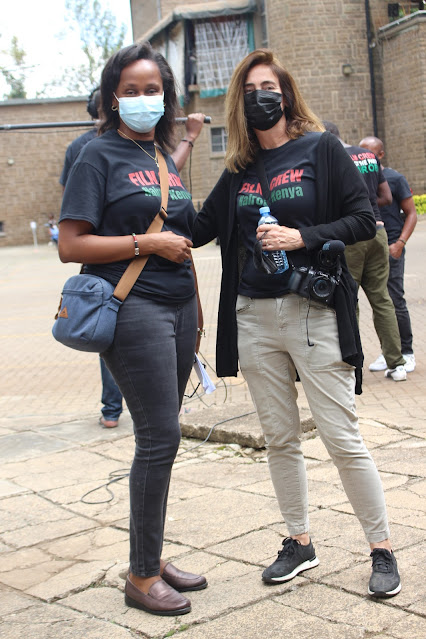By Margaretta wa Gacheru (drafted 27 April 2021)
Water
boarding, that infamous practice of interrogation and torture practiced widely
during the Iraq War, made a profound impression on Lincoln Mwangi.
He was still in his early teens the first time he saw it on CNN. But it made a lasting impression on this sensitive young Kenyan artist, according to the curator of his current solo exhibition, Veronica Paradinas Duro, CEO of Gravitart Gallery.
“Lincoln is
committed to conveying emotions and feelings through his art. He aims to
communicate the unseen more than the seen,” she adds.
Her
explanation is in response to my query as to why the faces of Mwangi’s
characters are invariably veiled. The archetypal animals, the goat and egret,
that often appear in the 40 paintings in his show are free from that
encumbrance. Could it be that the creatures embody innocence and freedom while
the veil conveys a sense of separation and concealment?
Veronica,
who’s an artist in her own right, suggests his works can have many
interpretations. But the collection which is up until mid-May in her Peponi
Gardens gallery, comes with Mwangi’s own esoteric code and symbolic language.
The code serves as a kind of key enabling one to appreciate the broader
significance of the artist’s creative concerns. It also allows one to see the
way even the title of his exhibition, “A Painted Book of Life, Time, and
Feeling” signifies the unity of all the paintings.
Without
Mwangi’s inventive code, one will miss out on how to translate his visual
language into meanings that make sense. For instance, the egret and the goat
have feminine and masculine qualities respectively. One further signifies the
sky while the other the ground. Colors also carry symbolic value, be they red,
blue, black, or white. And the person who recurrently appears in Mwangi’s
paintings is Wanjiru, who is his feminine symbol of every woman. Finally, the
other image that stands out in Mwangi’s work is the mango tree, which is said
to symbolize growth and shelter for the other characters in his book of life.
“All of
these images are meant to be archetypal,” says Veronica several days after the
show’s opening on April 11th. She adds that Mwangi intentionally
keeps Wanjiru veiled in order not to have us focus on her individuality, but
rather to see her in more “universal” terms, particularly in terms of the
feelings he aims to affect through his art.
So when one
sees these symbols set against a neutral backdrop, what’s significant is not
just the delicate details of his egret or the draping of Wanjiru’s gown, which
we can see in works like ‘Decisions’, ‘Anointing a Harvest’ and ‘Fire and
Ground’. It’s the unspoken interaction going on between the characters that he
wants you, the audience, to contemplate.
I especially like his goat portraits since Mwangi allows them to have individuality and character unlike his anonymous Wanjiru whose emotions feel ambiguous to me. Ironically, it is his goats which convey a depth of feeling that allows one to see them as conscious beings. The three portraits of Wanjiru that succeed at being contemplative are his ‘Silence I’, ‘Silence II’ and ‘Pleasure’. In these three, her body language communicates more than the stoical standing Wanjiru who is in a work like ‘Changes’ which is made with mixed media on linen. His other mixed media works are either on canvas or paper.
The other
innovation about Mwangi’s show, apart from his original language, is the
three-dimensional virtual exhibition that one can find on the Gravitart
website. Veronica, being an architect as well as an artist, works regularly
constructing virtual 3D structures for her clients. So it wasn’t difficult for
her to transfer Mwangi’s ‘Book’ of paintings onto a brand new gallery platform
that enables one to click around corners and see the entire show, including
clicks that will give you the full details of each painting and another click
to decide whether you want to buy the work or not. The price range of his art
runs from less than Sh30,000 to more than half a million. Then again, a
collector might want to buy the whole book which would pose a problem since several
have already gone. But then, everything’s negotiable.
Mwangi, a
BIFA graduate, can be found at his studio at Brush Tu in Buruburu.

























